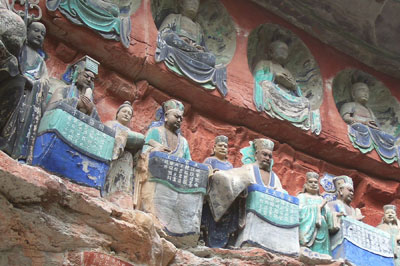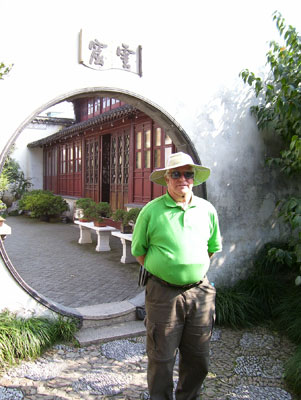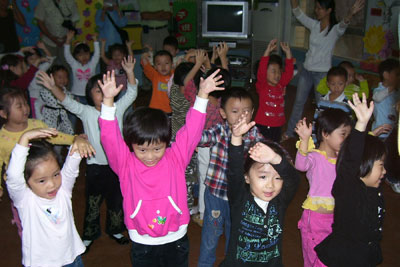A month-long visit to China continues
by Judy Licata and Marvin Herman, Delavan, WI
Following the first half of our 29-day “Journey of a Lifetime” with China Focus Travel (Aug.’08, pg. 38), it was time for our third internal flight; this one would take us to Lhasa in the Tibet Autonomous Region, southwest of Xi’an.
After the 4-hour flight, we arrived in Lhasa, where we stayed at the 4-star Thang Ka Hotel. On the way to the hotel, we passed the Potala Palace, the traditional winter residence of the Dalai Lama, now in exile in India.
Touring Lhasa
I slept until after 8 a.m., waking with a hard cough, blurred vision and muscle aches. I decided that I would still try to go to the Potala Palace. While it would require a climb of 600 steps, it beat sitting around the hotel all day.
My wife, Judy — with a migraine headache and bronchitis — rested in the room until she was well enough to tour again. That would turn out to be when we got down to a reasonable altitude. Almost everyone in our group was under the weather, to some extent, attributable to the high elevation.
That afternoon, 18 of us, led by our trusty Tibetan guide Penpa, mounted an assault on Potala Palace. All were able to ascend to the palace, but one person had to return to the hotel by pedicab.
As is so often the case, I felt the beauty and interest of the journey surpassed that of the final destination. Along the way, we saw many monks and pilgrims spinning prayer wheels and tossing money in bins as tributes to the various aspects of Buddha and the bodhisattvas. Colorful prayer flags festooned the walls. Outside the palace, people who had nothing to call their own begged for alms.
After another day’s touring, we departed for the Sera Monastery, founded in 1419. Penpa, himself, had been in training there for 17 years. It is now a protected relic of the People’s Republic of China.
At Sera we visited the open-air “debating courtyard” at which, each afternoon, monks assemble for debate. Certain monks, acting as inquisitors, stand and fire theological questions at responders, students seated on the gravel floor. As a point or response is given, the inquisitor claps his hands and stamps his feet, indicating his evaluation of the quality of the response, and then fires another question. Although the process sounds stressful, all seemed to be taken in a kindly spirit.
After dinner, five members of the group, myself included, opted for a Tibetan massage (180 yuan, or $24). We were all in one large room, where we were given tea and melon. The foot massage lasted an hour, and a final 30 minutes was devoted to a massage of the rest of the body.
My massage included a pedicure performed with a scalpel-like device — I couldn’t watch. I would recommend such a massage to anyone traveling in Tibet.
Back to China
The next morning we were up early for our flight to Chengdu, capital of Sichuan Province. We were met in Chengdu by a woman from our group who had requested to be flown out of Tibet due to altitude sickness. She was now feeling fine.
We were in Chengdu to visit its giant panda research base, but there seemed to be no firm plan for the afternoon. Some tour members complained about having to walk a considerable distance to see the pandas when there were trams available. Some tour members wanted to watch the brief introductory film on the pandas while others did not. This was a time when the tour leader should have taken charge, but that didn’t happen. However, we did see pandas and had chances to take pictures.
In Chengdu we stayed at the Tibet Hotel, a 5-star facility in a nice area of the city. We had a large room with a tub and separate shower. Unfortunately, we were there only one night.
Yangtze cruise
The next morning we boarded a bus for the 8-hour ride to Chongqing, where we would begin our Yangtze River cruise.
In the afternoon the smog and pollution became more intense, and by the time we arrived at Chongqing, a huge metropolitan area of 30 million, the atmosphere was pea-soup thick as the rush hour traffic went nowhere.
It was dark by the time we reached the dockside, and our guides stopped at a supermarket so we could load up on beer, wine and water, which they correctly represented as being much cheaper than what was available on the boat.
We dragged our heavy grocery bags and our carry-on baggage from the bus to a funicular which carried us down to the quay. From there, we boarded the President No. 6, owned by CITS President Cruises, a subsidiary of the Chinese government.
We were asked if we wanted to upgrade to a larger cabin on a higher deck, which we decided to do for an extra $80 for the entire 3-night cruise. However, this gave us the added pleasure of dragging our burdens up from deck 2 to deck 5, as there was no elevator.
The next day, after a statistic-laced lecture on the Yangtze, we disembarked to visit Fengdu, the “ghost city.” This involved walking up hundreds of steps just to get to ground level, then taking a tram and a ski lift.
The following day the weather had miraculously cleared and, although factories lined the riverbanks, we passed by green hills with large residences positioned sparsely upon them. There was a feeling of tranquility in the hills, as if they were sleeping, gathering strength for the busy tomorrow.
After lunch, we left the ship again for a tour of Shen Nong Stream, a tributary of the Yangtze. For this, we boarded a large ferryboat and traveled upstream for about 40 minutes. We then transferred to a sampan paddled and steered by seven men.
When the stream became too narrow and shallow, the “trackers” left the sampan to pull it along with ropes until the water deepened. “Tracking” is a traditional function of the Najia people, indigenous to the area. On our way upstream, we saw places where coffins were placed in niches in the sheer cliffs.
After a tour of the Three Gorges Dam Project, it was time to leave the Yangtze and make our way to Wuhan, a 4-hour drive away. Wuhan is one of the largest cities in China and it appeared very prosperous, with beautiful parks and water features, late-model cars, thriving businesses and well-dressed citizens. The center of the city is built on both sides of the Yangtze, with bridges providing access across.
After breakfast the next morning, we paid a visit to the Hubei Provincial Museum, one of China’s best, with artifacts from the tomb of the Marquis Yi, an eminent figure of the Warring States Period who died in 433 B.C. He was buried in a lacquer coffin with his concubines, his dog and various bronze, stone and wooden items.
Also buried with the marquis was a collection of bells which each produce two notes when struck. We were fortunate to attend a 20-minute bell concert featuring the famous bells of Hubei Province.
Following a visit to the city of Guilin, we continued our journey with a cruise down the Li River to Yangshuo. The cruise should have taken about four hours, but, owing to the shallow water, it took the entire day.
After our arrival, we were taken to a performance of “Impression Sanjie Liu,” a spectacle staged in a natural theater on the water and on the banks of the Li River.
The performance lasted an hour and had a cast of over 800. It featured artistic lighting, beautiful costumes and dance, its only weakness being that it did not have live music.
What really made this unforgettable was the venue in the Li River, with natural karst formations in the background and water in the foreground and a beautiful autumn moon in the black sky.
There was an extra charge for this event (about $40 per person), which was not listed on the tour itinerary because of the uncertainty of the river level, which might have required cancellation of the performance.
Suzhou
Returning by bus from Yangshuo to Guilin (two hours), we took a 2-hour flight to Shanghai. Before boarding, we were told that our check-in bags were slightly overweight (by about five pounds) and we had to pay an extra 40 yuan ($6). We had understood that this airport was strict in this regard, and we were prepared for this eventuality. About half the group’s luggage was also overweight, some as much as 25 pounds. Suffice to say, they paid much more.
We landed at the regional (Hongqiao) airport 12 miles west of Shanghai and proceeded south, two hours by bus, to Suzhou, a city of 12 million in Jiangsu Province. We would spend two nights at the Glamor Hotel. This was one of the best hotels we stayed at in China, with a nice shower and wooden floor.
Suzhou, the silk center of China, is also known for its gardens. Its Grand Canal, built beginning in the fourth century B.C. and expanded in the fifth century A.D., measures about 1,000 miles in length.
Getting up at 6:30 on a warm, smoggy day, we were exhausted. It felt like we were in a marathon, with everyone staggering to the finish line. For the first time since we left, I thought of home.
After a visit to the silk factory, we proceeded to Master of the Nets Garden, a UNESCO World Heritage Site. The local guide insisted on showing us each detail of the Ming furniture on display in the outdoor rooms that we visited as a prelude to the garden itself. The garden was a lovely spot, with a large pond stocked with koi swimming beneath lotus pads. We lingered at the beautiful pagoda for about 20 minutes, taking in the peaceful surroundings.
We then boarded a canal boat for a one-hour ride. It was nice to see the neighborhoods along the canal much as they have been for hundreds of years.
Shanghai
We left Suzhou the next morning and drove two hours to Shanghai, where we checked into Hotel General. Our room was large and nicely decorated, but the hotel was located in the French Concession, far west of the Bund and the Huangpu River, the main tourist area.
We were then taken to the Bund, along the river, which was mobbed with foreign travelers and persistent peddlers of all manner of tourist merchandise. We walked around as best we could, buying only melon on sticks to eat.
We walked to Nanjing Road, one of Shanghai’s major shopping streets. There, even more persistent agents tried to drag visitors to off-the-street locations where they promised cheap goods of every kind, especially “knockoff” designer watches. But it was great fun to watch the people strolling down the street and to see families out for the day to take in the less-than-fresh air.
Our final morning in China was spent on the bus to Pudong International Airport, the larger of the Shanghai airports, for our flight to Beijing and on to San Francisco. On the way, our guide Toby recapped our journey, triggering memories of the places we had been and the things we’d seen.
While it took a while to get over the jet lag, we will never forget the experience we had. I don’t know if we will return to China, but I could not have asked for a more comprehensive and informative tour.
For more information, contact China Focus Travel (San Francisco, CA; 800/868-7244, www.chinafocustravel.com).





